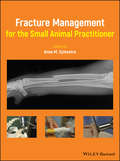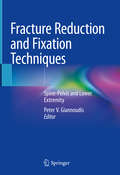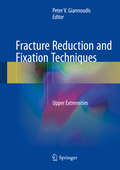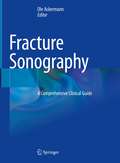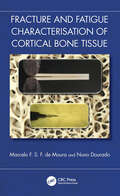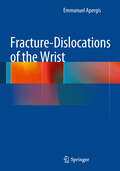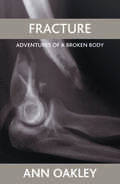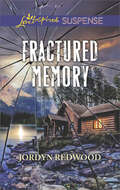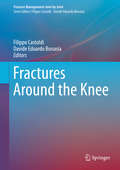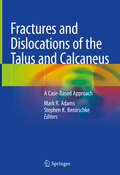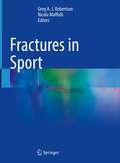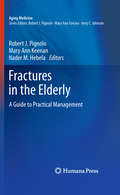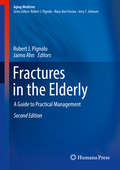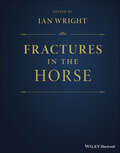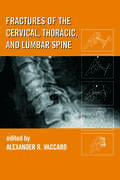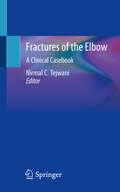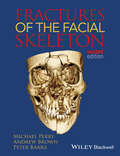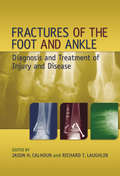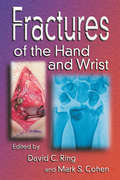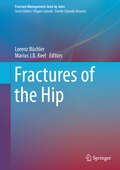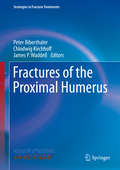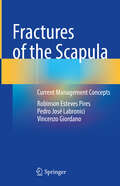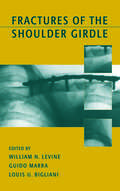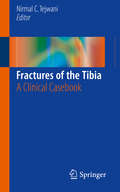- Table View
- List View
Fracture Management for the Small Animal Practitioner
by Anne M. SylvestreFracture Management for the Small Animal Practitioner offers practical strategies and helpful approaches for managing fractures in dogs and cats. • Contains all the information needed to successfully manage the most common fractures in dogs and cats • Emphasizes clinically oriented tips for treating fractures from experienced surgeons • Offers an abundance of color photographs to illustrate the techniques
Fracture Reduction and Fixation Techniques: Spine-Pelvis and Lower Extremity
by Peter V. GiannoudisThis book is the second volume on Osteosynthesis of Fractures and focuses on fractures of the spine-pelvis and lower extremities. It illustrates the techniques of fracture reduction clearly, using a step-wise approach with real time intra-operative photographs. Tips and tricks for how to avoid pitfalls are presented by a panel of experts to give the readers a complete overview of how to perform reduction techniques for different fracture types.This book will be an essential guide for surgeons to utilise the available reduction instruments and preserve the vitality of the bone and surrounding soft tissues.
Fracture Reduction and Fixation Techniques: Upper Extremities
by Peter V. GiannoudisIn this highly illustrated book, the techniques of fracture reduction are clearly demonstrated using a step-wise approach with real time intra-operative photographs. Tips and tricks for how to avoid pitfalls are presented by a panel of experts and all upper extremity anatomical sites are included to give the readers a complete overview of how to perform reduction techniques for different fracture types. This book will be an essential guide for surgeons to utilise the available reduction instruments and preserve the vitality of the surrounding soft tissues and bone.
Fracture Sonography: A Comprehensive Clinical Guide
by Ole AckermannFilling a gap in the literature, this is the first book to comprehensively present fracture sonography as a diagnostic tool that can complement and in some cases even replace conventional radiological imaging. Guiding readers step by step through a patient examination, it is an invaluable guide to implementing this technique in clinical practice. It also presents algorithms, tips, tricks and pitfalls shared by experienced authors, making it a useful reference resource for all those practicing in the field. This book is of interest to a wide readership, including orthopedic, pediatric and trauma surgeons, emergency physicians, pediatric radiologists and general practitioners.
Fracture and Fatigue Characterisation of Cortical Bone Tissue
by Marcelo F. de Moura Nuno DouradoFracture and Fatigue Characterisation of Cortical Bone Tissue is a key guide to bone fracture and fatigue, focusing on quasi-static and fatigue-fracture characterisation of cortical bone tissue. Discussing the fundamental aspects of fracture mechanics and fatigue, which are applicable to many orthotropic materials, this book examines novel, cutting-edge approaches to analyse and model bone fracture and fatigue.As the population ages across the globe, bone fracture and fatigue has become a fundamental part of mechanical and biomedical engineering research. Beginning with a thorough description of fracture mechanics and fatigue, the book describes non-linear fracture mechanics under quasi-static and fatigue analyses. It goes on to present a cohesive zone modelling method which is appropriate for mode I, mode II and mixed-mode I+II loading. Presenting the latest research, this book describes cutting-edge fracture tests, new methods for data reduction purposes and numerical models based on cohesive zone modelling. This book is key to aiding both students and professionals in applying fundamental theories and methods to cortical bone tissue.The book will be of interest to students and professionals working in mechanical engineering and biomedical engineering, including work on quasi-static fracture, fracture under fatigue loading, artificial bones and fracture mechanisms.
Fracture-Dislocations of the Wrist
by Emmanuel ApergisAccording to reports in the literature, despite the severe disruption of carpal anatomy, fracture-dislocations of the wrist are missed on clinical and radiographic examination in a high percentage of cases. Orthopedic surgeons' lack of familiarity with these injuries is one of the factors contributing to failed or delayed diagnosis. This richly illustrated book covers all types of wrist dislocation and fracture-dislocation. Detailed information is provided on anatomy and biomechanics, while terminology and classification of injuries are explained. Treatment options are thoroughly analysed, with special emphasis on surgical treatment, which is presented step by step. All of the figures - radiological and surgical - relate to patients treated by the author himself. Most of the cases are from the Red Cross Hospital of Athens that admits many patients with such injuries, in part through referral from other centres due to the author's acknowledged expertise in the field. This volume, with its highly informative and up-to-date chapters and reviews, and a wealth of color figures, will be of great practical value for clinicians and residents in orthopedic surgery, who assist them in daily decision making.
Fracture: Adventures of a broken body
by Ann OakleyThe starting point of Ann Oakley's fascinating book is the fracture of her right arm in the grounds of a hotel in the USA. What begins as an accident becomes a journey into some critical themes of modern Western culture: the crisis of embodiment and the perfect self; the confusion between body and identity; the commodification of bodies and body parts; the intrusive surveillance and profiteering of medicine and the law; the problem of ageing; and the identification of women, particularly, with bodies - from the intensely ambiguous two-in-one state of pregnancy to women's later transformation into unproductive, brittle skeletons. Fracture mixes personal experience (the author's and other people's) with 'facts' derived from other literatures, including the history of medicine, neurology, the sociology of health and illness, philosophy, and legal discourses on the right to life and people as victims of a greedy litigation system. The book's genre spans fiction/non-fiction, autobiography and social theory.
Fractured Memory
by Jordyn RedwoodTo escape a serial killer, a woman with no memory must trust the man who says he saved her life in this tense romantic thriller.United States marshal Eli Cayne saved Julia Galloway’s life once . . . and he’s prepared to do it again. But his task would be easier if she had any memory of him—or the murderer who seems to be hunting her once again To protect Julia from the latest threat against her life, Eli has to consider the possibility that he put an innocent man in jail. Julia has no memories of the serial killer called the Hangman, though, and no reason to trust Eli. But with the killer getting closer, she must work with Eli to confront her past—and the feelings growing between them.
Fractures Around the Knee
by Filippo Castoldi Davide Edoardo BonasiaThis comprehensive book is more than a complete reference on knee fractures and associated injuries: it is also a decision-making and surgical guide that will assist trauma, knee, sports medicine, and total joint surgeons in planning and executing specific procedures for different traumatic conditions of the knee. Each chapter addresses a particular condition and its management, explaining the traumatic mechanism and preoperative workup and then describing in detail the surgical steps, from patient positioning to the postoperative regimen. Guidance is also provided on complications and their management, and to complete the coverage, results from the relevant literature are described. The authors are world-renowned experts keen to share their knowledge and expertise regarding specific traumatic conditions of the knee. Both experienced surgeons and orthopedic residents will find this book to be an invaluable tool that will improve their practice when dealing with knee fractures.
Fractures and Dislocations of the Talus and Calcaneus: A Case-Based Approach
by Mark R. Adams Stephen K. BenirschkePresenting an in-depth discussion of the surgical management of fractures and dislocations of the talus and calcaneus, this text utilizes both an up-to-date review of the literature, providing a broad understanding of the topic, and a case-based approach, delving into the finer details of how to care for these injuries and providing an outline of the specific surgical techniques that make anatomic repair of these injuries possible. Beginning with a review of the general principles of foot trauma care, the chapters then proceed thematically to cover various fractures of the talus, tarsal dislocations, fractures of the calcaneus, and post-traumatic care and reconstruction. There is a focus throughout on the care of the post-traumatic sequelae of these injuries, as these frequently lead to chronic issues about the foot and ankle. Amply illustrated with figures, radiographs and intra-operative photographs, Fractures and Dislocations of the Talus and Calcaneus will be an excellent resource for orthopedic, podiatric and trauma surgeons and residents.
Fractures in Sport
by Nicola Maffuli Greg A. J. RobertsonThis textbook provides a practically applicable sport-centred guide to fracture management for athletes. It features extensive evidence-based guidance on how fracture management can be adapted in athletic patients, to facilitate an accelerated return to sport. Descriptions of a variety of both acute and stress fracture types are included, covering both the appendicular and axial skeleton, in locations such as the shoulder, knee, ankle and spine. Throughout the book, the focus is on enabling the reader to develop a deeper understanding of the ideal management principles that are available for managing fractures in high-functioning patients. Fractures in Sport comprehensively covers the available strategies for managing fractures in professional and amateur athletes, and is ideal for use by practising and trainee orthopaedic surgeons, sports physicians, and general practitioners.
Fractures in the Elderly
by Nader M Hebela Mary Ann Keenan Robert J. PignoloFractures in the Elderly: A Guide to Practical Management provides geriatricians and other medical specialists who provide care for older adults with the vital guidance and most current data and opinions regarding the treatment of elderly patients who sustain a variety of fractures. It also provides orthopedic surgeons with the necessary information and most current data and opinions regarding assessment and management of geriatric conditions that predispose the elderly to fracture, perioperative complications and subsequent functional decline. Each chapter is both readable and appealing not only to geriatricians and orthopedic surgeons but to all clinicians that have contact with elderly patients who have sustained or are at high risk of sustaining a fracture. Emphasis is placed on the fact that although in some cases pre- and post-operative care in elderly fracture patient may proceed as it does in younger individuals, often there are considerations owing to functional status, pre-existing conditions, and age-related physiological declines that require specialized knowledge and alternative approaches. Developed by a group of renowned experts, Fractures in the Elderly: A Guide to Practical Management is a major addition to the literature and provides a wealth of specialized knowledge and approaches to care. It is an essential reference for all clinicians who care for older adults as well as fellows and residents in training.
Fractures in the Elderly: A Guide To Practical Management (Aging Medicine Ser.)
by Robert J. Pignolo Jaimo AhnNewly revised and updated, this book provides geriatricians and orthopedic surgeons with the most vital tools to treat elderly patients who sustain a variety of fractures. The text uniquely encompass the etiologies of fracture in the elderly, perioperative management, the surgical treatment of common fractures in the elderly, as well as rehabilitation and prevention in the older patient. It focuses on the most current data and opinions regarding assessment and management of geriatric conditions that predispose the elderly to fracture, perioperative complications and subsequent functional decline. Unlike any other text, experts in both orthopedics and geriatrics review the content of each chapter for readability and appeal to his/her respective discipline, making this the physician’s ultimate guide to treating elderly patients with injuries. Fractures in the Elderly, Second Edition is a valuable resource for geriatricians, orthopedic surgeons, physiologists, and rehabilitation specialists.
Fractures in the Horse
by Ian WrightFractures in the Horse is a comprehensive contemporaneous reference on the subject. The first 15 chapters deal with principles such as: Bone structure and function, physiological aspects of adaptation, stress protection and ultrastructural morphology. The pathophysiology of fractures, including material features of bone failure, modes of fracture, loading characteristics, stress and strain. Fracture epidemiology including geographic, discipline and horse level incidence, risk factors and variants and predictability. Diagnostic imaging including radiography, ultrasonography, scintigraphy, magnetic resonance imaging, computed tomography and positron emission tomography. Acute fracture management, pre-operative planning, anaesthesia and analgesisa, standing fracture repair and management of complications. Surgical equiptment and repair techniques, external coaptation and rehabilitaion. The following 22 chapter cover all clinically relevent fractures. Each describes the relevent anatomy, fracture types, incidence and causation, clinical features and presentation, imaging and diagnosis, acute fracture mangement, treatment options and techniques and documents available results: author’s recommendations are made throughout. Fractures in the Horse represents a state of the art text for all involved in equine veterinary medicine. It is a manual for surgeons, diagnosticians, residents and interns. It will serve as a reference text for veterinary practitioners for managing fractures and suspected fractures in the field, advising clients and decision making. Individual chapters will also be relevent to anaesthetists, surgery and imaging personnel.
Fractures of the Cervical, Thoracic, and Lumbar Spine
by Alexander R. VaccaroThis reference focuses on individualized spinal injury assessments, immobilization techniques, nonoperative and operative indications, operative fixation strategies, and prognoses. Containing over 1900 references, Fractures of the Cervical, Thoracic, and Lumbar Spine is an invaluable resource for orthopedic, spinal, and trauma surgeons; neurosurgeo
Fractures of the Elbow: A Clinical Casebook
by Nirmal C. TejwaniComprised exclusively of more than 20 clinical cases covering common fractures of and around the elbow, this concise, practical casebook will provide clinicians with the best real-world strategies to properly manage open and closed fractures, dislocations and nonunions of the distal humerus and proximal radius and ulna. Each chapter is a case that opens with a unique clinical presentation with associated radiology, followed by a description of the diagnosis, assessment and management techniques used to treat it, as well as the case outcome and clinical pearls. Cases included illustrate the surgical management of intra- and extra-articular fractures of the distal humerus, coronal shear, coronoid and olecranon fractures, the “terrible triad,” Monteggia fractures, and complications, among others. Pragmatic and reader-friendly, Fractures of the Elbow: A Clinical Casebook will be an excellent resource for orthopedic surgeons and sports medicine specialists confronted with these common injuries of the elbow.
Fractures of the Facial Skeleton
by Michael Perry Andrew Brown Peter BanksFractures of the Facial Skeleton, 2nd edition, incorporates developments and improvements in maxillofacial trauma management into a practical handbook ideal for postgraduate students and trainees. New, updated edition of a well-respected text Easy-to-read, practical clinical handbook Summary text boxes and colour illustrations enhance comprehension Expanded sections on diagnostic imaging and soft tissue injury
Fractures of the Foot and Ankle: Diagnosis and Treatment of Injury and Disease
by Jason H. Calhoun Richard T. LaughlinWith contributions from an established team of experts on the subject, this reference illustrates current practices and techniques in the care of patients with foot and ankle fractures-demonstrating treatment methods for fractures and dislocations, pediatric injuries, soft tissue management, crush injury, and post-traumatic reconstruction.
Fractures of the Hand and Wrist
by Mark S. Cohen David C. RingThis straightforward and reader-friendly guide provides the most up-to-date treatment options for fractures and dislocations of the hand and wrist. A convenient reference for clinical decision-making, this source analyzes a wide variety of conditions the physician must consider during fracture repair including the nature, type, and stability of the
Fractures of the Hip (Fracture Management Joint by Joint)
by Lorenz Büchler Marius J. B. KeelThis book is a state-of-the-art reference resource for surgeons treating patients with intra-articular fractures of the hip. It serves as a guide to assessing and classifying typical fracture patterns to reach the correct diagnosis and helps select the appropriate up-to-date treatment strategy. It describes in detail the complex anatomy of the acetabulum and proximal femur, and also explains the assessment of various radiological imaging techniques for the pelvis and the hip. The book highlights the advantages and disadvantages of traditional as well as newer surgical approaches to the hip and pelvis, such as surgical hip dislocation, hip arthroscopy, the pararectus approach, and combined approaches. For each surgical approach, the authors identify typical complications and document long-term outcomes. It also includes chapters on the management of specific fracture types, such as acetabular, femoral head (Pipkin), and femoral neck fractures, as well as traumatic hip dislocations, and pathological fractures due to osteoporosis or tumors. This book is part of the series Fracture Management Joint by Joint.
Fractures of the Pelvis and Acetabulum
by Steven J Morgan Wade R Smith Bruce H ZiranRepresenting the vanguard in the field with practical case studies, authoritative recommendations, and a collection of best practices in operative and non-operative treatment, this reference offers step-by-step guidance in the correction and care of fractures affecting the actabulum and pelvis. Detailing procedures in pre- and postoperative plannin
Fractures of the Proximal Humerus
by Peter Biberthaler Chlodwig Kirchhoff James P. WaddellThis series provides a clearly structured and comprehensive overview of fracture treatments based on the most recent scientific data. Each book in the series is organized anatomically, so the surgeon can quickly access practical aspects, examples, pearls and pitfalls. In this first volume in the series, fractures of the proximal humerus are examined with an overview of fracture morphology, injury pattern, preoperative considerations, conservative treatment, surgical management and postoperative care. Fractures of the Proximal Humerus is written by a group of experts from the Association for the Rationale Treatment of Fractures (ARTOF) who aim to provide an independent, unbiased summary of fracture treatments to improve clinical outcomes. Trauma and orthopaedic surgeons worldwide who are searching for current knowledge of new implants, therapeutic strategies and advancements will be able to quickly and accurately apply the information from this book to provide the best possible care for their patients.
Fractures of the Scapula: Current Management Concepts
by Robinson Esteves Pires Pedro José Labronici Vincenzo GiordanoFractures of the scapula are usually associated with high-energy trauma and its management has deeply changed in the last decade. The unfavorable scapular anatomy, combined with the complexity of the approaches for fracture fixation, make the treatment challenging, even for experienced surgeons. Furthermore, the literature is controversial regarding surgical indications and rationale for treatment. This book is designed to address and discuss critical aspects of decision making for the management of scapular fractures, including anatomy, epidemiology, surgical indications, rehabilitation, treatment, and outcomes. It also presents several challenging cases with adequate preoperative planning, emphasizing the different approaches, fixation strategies, soft tissue handling, and postoperative care. Floating shoulder and the association between scapular fractures and clavicle fractures are also addressed, as well as a hot topic and emerging issue: the periprosthetic scapular fracture following reverse shoulder arthroplasty. The approaches and fixation strategies will be the main points of the book and richly illustrated by images. Fractures of the Scapula – Current Concepts is an indispensable reference to shoulder surgeons, general orthopaedic surgeons, orthopaedic trauma surgeons, thoracic surgeons, orthopaedic fellows and residents, medical students, and physical therapists who are eager to deepen their knowledge in the management of the challenging scapular fractures. *the Editors modified the proposal based on the reviewer’s feedback.
Fractures of the Shoulder Girdle
by William N. Levine Guido MarraThis title offers guidelines to avoid complications in the diagnosis, management, repair and rehabilitation of common, complex and multifaceted fractures of the shoulder girdle. It emphasizes critical issues in clinical and radiographic evaluation for optimal surgical outcomes. The text is also illustrated to clarify diagnostic, surgical and therap
Fractures of the Tibia
by Nirmal C. TejwaniComprised exclusively of nearly two dozen clinical cases covering fractures of the tibia, this concise, practical casebook will provide orthopedic surgeons with the best real-world strategies to properly manage injuries to the tibial shaft, plateau and pilon, as well as deformities, nonunions and bone loss. Each chapter is a case that opens with a unique clinical presentation, followed by a description of the diagnosis, assessment and management techniques used to treat it, as well as the case outcome and clinical pearls. Cases included illustrate different management strategies for Schatzker (I-VI) tibial plateau fractures, plates and screws for proximal tibia fracture, intramedullary nailing for midshaft and distal tibial fracture, and the use of Ex-Fix with open tibia and distal pilon fracture, in addition to Masquelet bone grafting and modified clamshell osteotomy for acute shaft fracture. Pragmatic and reader-friendly, Fracture of the Tibia: A Clinical Casebook will be an excellent resource for orthopedic surgeons confronted with various injuries to the shin.
